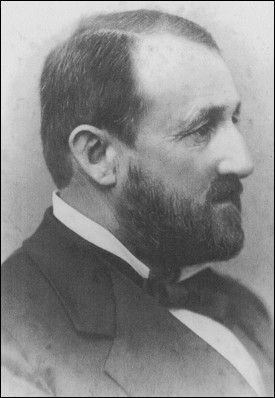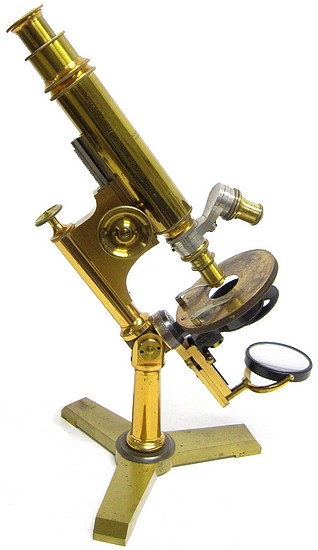
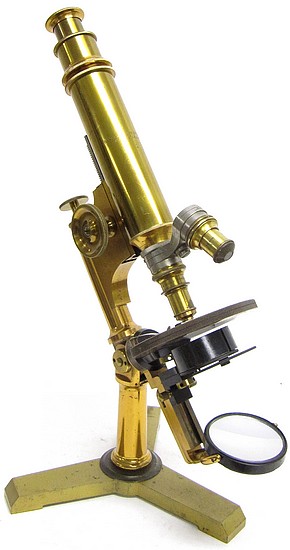
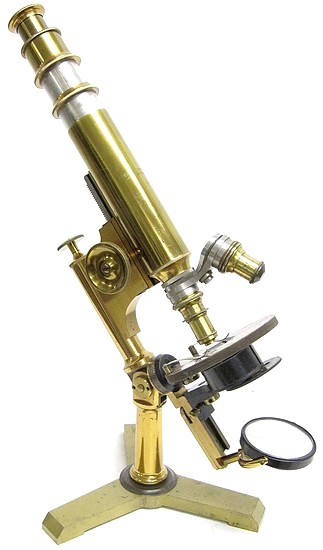
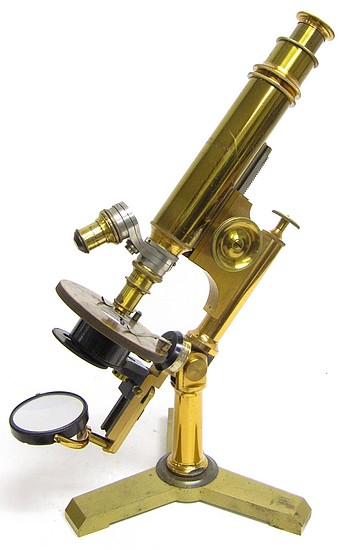
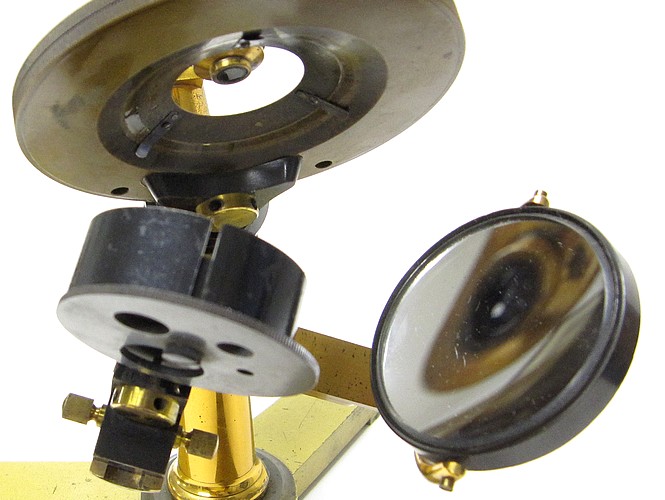
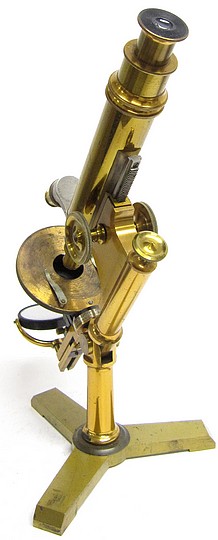
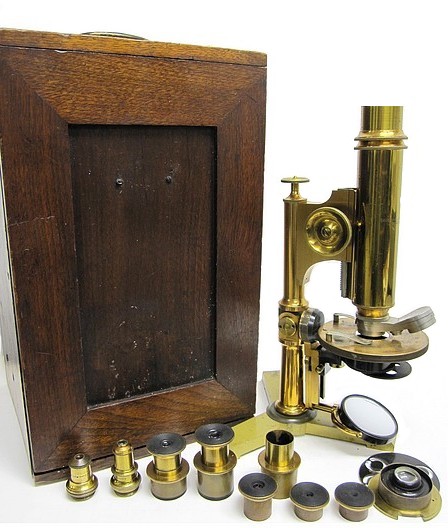
Among the accessories are two objectives, two conventional eyepieces, three solid high power eyepieces marked 1/2, 1/4, and 1/8 with adapter, custom made Abbe condenser, later double nosepiece, and a substage diaphragm constructed of hard rubber.
This instrument is an example of the earliest version of the Investigator model as indicated by having the mirror glasses mounted in hard rubber. The tripod base is thinner and also has a different shape than that found on later versions, two of which are shown elsewhere on this website. Curiously, this microscope does not have a serial number, which is usually stamped on the inside bottom of the wood case, and it also lacks the Oct. 3, 1876 patent date, which is usually engraved on the limb.
The following was extracted from the catalog of August Stendicke, New York: Illustrated & Descriptive Catalogue of Optical Instruments c.1890
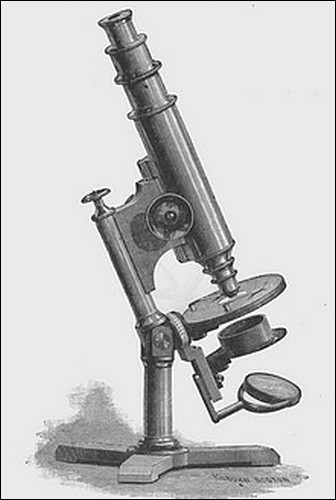
THE
INVESTIGATOR MICROSCOPE
In this stand I confidently claim to have reached a higher degree of perfection than is possessed by anyone approximating it in price. It combines, in a moderate-priced instrument, the features of a first-class and high-priced stand at no sacrifice of its working qualities. The different parts are ingeniously combined, are strong and firm, and in the parts subject to friction I have introduced, as much as possible, new compensating bearings, which enable the instrument to endure any amount of work and still retain smooth and reliable movements, Working microscopists will understand the value of this quality. When contracted, it stands but 11 inches high, but can be extended to 18 inches. The base is of brass, and has the tripod form: pillar and arm of brass, connected by a solid joint, which allows inclination of body to any angle; rack and pinion for coarse adjustment, fine adjustment by our patent frictionless motion; main tube, with two draw tubes. This is an entirely new feature in Microscopes, which is an unquestionable improvement. It permits the use of standard length of tube for quick adjustment ill outside tube, same as in instruments without rack and pinion adjustment; the same for any low power objective and the use of amplifier in either combination. The outside tube has a broad gauged screw, and adapter with society screw. The stage lies in the same plane as centre of movement for mirror, is of brass, and has concentric, revolving motion with removable clips. It is thin to allow great obliquity, and, as it rests upon a strong projecting arm, is perfectly firm under any manipulation.
The mirror-bar swings with a perfectly easy but
firm motion, upon one bearing to any obliquity
below, and above the stage for the illumination of
opaque objects, and has affixed to it a secondary
bar, to which the mirror is attached and which
allows the separate use of the latter in any
position of the sub-stage. It is provided with a
sliding arrangement, whereby the mirror may be
moved to and from the object. The mirrors are plain
and concave, and of large size. The sub-stage is
adjustable along the mirror-bar and entire
removable. It contains a diaphragm which may be
brought directly under the stage. The ring is of
standard size and is easily centered by a
set-screw. Steel pin for centering stage and
sub-stage accompanies the instrument.
Eye-pieces A and C, the latter arranged with slot
for micrometer. Objectives, 3-4 inch and 1-5
inch.
Camera lucida, eye-piece micrometer, pliers, slides
and covers. Magnifying powers, 35 to 600
diameters.
In upright walnut case, with handle and lock, drawer
for accessories, and receptacles for eye-pieces and
objectives, - $70.00
The above, when double nose-piece is ordered with it,
- 75.00
Same stand, with any power eye"piece, in above
case, - 45.00
The above, with improved glass stage and slide
carrier, which fastens to the brass stage, extra, -
5.00
This microscope was purchased from the great, great, grandson of the original owner, Dr. Joseph Byron Hayes II (1834-1890). The following was extracted from A History of Ontario County, New York and Its People, vol II, pg 5, 1911:
"Dr. Joseph Byron (2) Hayes, son of Joseph Byron (1) and Sarah (Antis) Hayes, was born in Canandaigua, May 11, 1834. He prepared for college at Canandaigua Academy, from which he entered Williams College, graduating with the class of 1854, and his professional studies were completed in the medical department of the University of Pennsylvania, where he was graduated a doctor of medicine in 1860.His life was spent in Canandaigua, in the practice of his profession. He was an active member of the county and village medical societies and was a deacon of the Congregational Church from early manhood until his death, which occurred July 17, 1890. On September 24, 1861, he married, in Canandaigua, Louise Anne Coleman, born in Frederick, Maryland, September 24, 1833, died in Canandaigua, March 22, 1884, daughter of Chester and Eliza (Graham) Coleman, of Canandaigua. Children, all born in Canandaigua: Edward Graham, mentioned below; George Byron, born July 20, 1865; Chester Coleman, July 31, 1867; Harriet Louisa, May 16, 1871, died April 21, 1875.”
